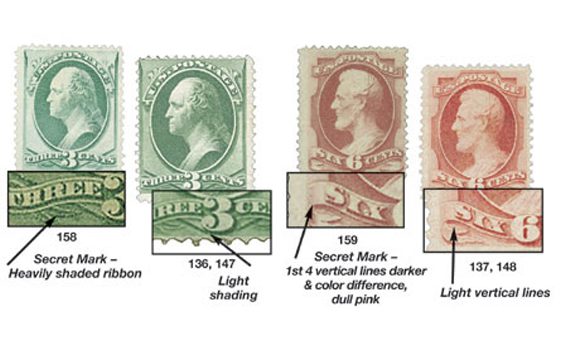Do You Know Where to Find Secret
Marks On Classic U.S. Stamps?
As stamp collectors, we love to have the “inside” story. It’s fun to know things about stamps others would certainly overlook. The Bank Note stamps on this page, with their “secret marks,” are great fun for us. Identifying these sought-after classic stamps can be as easy (or difficult) as finding a tiny design difference intentionally placed there by the stamp printer. Without these hidden design elements, it would be extremely difficult to properly identify these stamps. But, aided by the proper information, you’ll be able to identify them like a pro!
Secret Marks Used By Printer to
Distinguish Look-Alike Stamps
On May 1, 1873, the Continental Bank Note Company received the government contract to produce U.S. stamps. Continental took over some of the materials the former stamp printer, the National Bank Note Company, had used to produce the stamp issue of 1870-71. These goods included dies and plates. So with the exception of inks and paper, Continental was producing the same exact stamps.
Officials at Continental wanted a way to easily distinguish the stamps they produced from the ones National had manufactured – possibly because there had been complaints about stamp quality in the past. So “secret marks” were introduced on the 1¢ through 15¢ stamps.
It’s Great Fun Exploring these Old Stamps –
Compare Them Side-By-Side!
The following illustrations give you the inside scoop on secret marks and their locations, as well as other helpful identification tips. To really explore these stamp designs, you’ll want to have a good magnifier. It will make working with these stamps much easier and much more rewarding. You’ll love the detail…these stamps are beautifully engraved.
|




